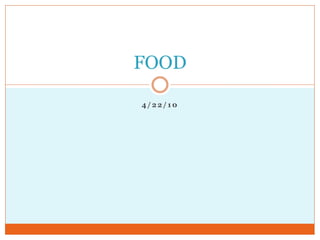Food
- 1. FOOD 4/22/10
- 2. Where Does Our Food Come From?
- 6. Why is it so expensive to eat healthy? ’éŚ Healthy food is rich in nutrients and low in calories ’éŚ Price of healthy food increased over 20% in two years ’éŚ Healthy eating is becoming unaffordable ’éŚ People never thought that might be that expensive
- 7. Organic Food & Vegetarian Diets ’éŚ Organic food ’éĪ Really regulated industry, special certificates ’éĪ Not everybody can afford it, healthy ’éĪ http://www.organic.org/goorganic/ ’éŚ Vegetarian diets ’éĪ A diet on plant-based foods ’éĪ Usually people who concerned with animal rights, environment ’éĪ Must eat wide variety of food to meet their needs ’éĪ http://www.nlm.nih.gov/medlineplus/vegetariandiet.html
- 9. The New Pyramid The small yellow area is oils (sugar has been removed from the pyramid.)
- 10. Why the Change? ’éŚ Many blamed the old pyramid for childhood obesity. ’éŚ Many people misunderstood the range in what to eat and how much they should consume or couldnŌĆÖt understand it. ’éŚ The new pyramid is more interactive. ’éŚ No more servings, just recommendations (according to a 2,000 calorie diet) along with better eating and exercise habits.
- 11. Grains: Whole and Refined Any food made from wheat, rice, oats, cornmeal, barley or another cereal grain is a grain product. Bread, pasta, oatmeal, breakfast cereals, tortillas, and grits are examples of grain products. Whole grains: Refined grains: brown rice whole rye whole wheat bread buckwheat whole wheat crackers cornbread* bulgur (cracked wheat) whole wheat pasta pitas* corn tortillas* oatmeal whole wheat sandwich buns pretzels couscous* popcorn and rolls crackers* whole wheat tortillas Ready-to-eat breakfast cereals Ready-to-eat breakfast flour tortillas* wild rice corn flakes cereals: grits Less common whole grains: noodles* whole wheat cereal flakes white bread amaranth muesli millet white sandwich buns and rolls Pasta* whole grain barley quinoa white rice. spaghetti whole grain cornmeal sorghum macaroni triticale
- 12. Vegetables Orange vegetables: acorn squash Any vegetable or 100% vegetable juice counts as a member of butternut squash carrots the vegetable group. Vegetables may be raw or cooked; fresh, hubbard squash frozen, canned, or dried/dehydrated; and may be whole, cut-up, or pumpkin sweet potatoes mashed. Dry beans and peas: Dark green vegetables: Other vegetables: bok choy black beans artichokes broccoli black-eyed peas asparagus collard greens bean sprouts garbanzo beans (chickpeas) dark green leafy lettuce okra beets kidney beans kale onions Brussels sprouts lentils mesclun parsnips cabbage mustard greens tomatoes lima beans (mature) cauliflower romaine lettuce tomato juice navy beans celery spinach vegetable juice cucumbers pinto beans turnip greens turnips eggplant soy beans watercress wax beans green beans split peas green or red peppers zucchini tofu (bean curd made from soybeans) Starchy vegetables: iceberg (head) lettuce corn mushrooms white beans green peas lima beans (green) potatoes
- 13. Fruits Some commonly eaten fruits are: Apples Apricots Avocado Mixed fruits: Bananas fruit cocktail Any fruit or 100% fruit juice Nectarines Berries: Oranges counts as part of the fruit group. strawberries Peaches blueberries Pears Fruits may be fresh, canned, raspberries Papaya frozen, or dried, and may be whole, Pineapple Cherries Plums cut-up, or pureed. Grapefruit Prunes Grapes Raisins Kiwi fruit Tangerines Lemons Limes 100% Fruit juice: Mangoes orange Melons: apple grape cantaloupe grapefruit honeydew watermelon
- 14. Milk ’éŚ All fluid milk products and many foods made from milk are considered part of this food group. Foods made from milk that retain their calcium content are part of the group, while foods made from milk that have little to no calcium, such as cream cheese, cream, and butter, are not. Most milk group choices should be fat-free or low-fat. All fluid milk: Hard natural cheeses: fat-free (skim) cheddar low fat (1%) mozzarella reduced fat (2%) Swiss whole milk parmesan flavored milks: soft cheeses: chocolate ricotta strawberry cottage cheese lactose reduced milks processed cheeses lactose free milks American Milk-based desserts: All yogurt: Puddings made with milk Fat-free ice milk low fat frozen yogurt reduced fat ice cream whole milk yogurt
- 15. Nick Heppner ’éŚ http://www.youtube.com/watch?v=j7QpBm07Gl8& NR=1 ’éŚ http://www.nms.on.ca/Elementary/exploring_nutri tion.htm
- 16. Meat & Beans ’éŚ Dry beans and peas are the mature forms of legumes such as kidney beans, pinto beans, lima beans, black-eyed peas, and lentils. These foods are excellent sources of plant protein, and also provide other nutrients such as iron and zinc. They are similar to meats, poultry, and fish in their contribution of these nutrients. Many people consider dry beans and peas as vegetarian alternatives for meat. However, they are also excellent sources of dietary fiber and nutrients such as folate that are low in diets of many Americans. These nutrients are found in plant foods like vegetables. ’éŚ Because of their high nutrient content, consuming dry beans and peas is recommended for everyone, including people who also eat meat, poultry, and fish regularly. The Food Guide includes dry beans and peas as a subgroup of the vegetable group, and encourages their frequent consumptionŌĆöseveral cups a weekŌĆöas a vegetable selection. But the Guide also indicates that dry beans and peas may be counted as part of the ŌĆ£meat, poultry, fish, dry beans, eggs, and nuts group.ŌĆØ
- 17. Oils ’éŚ Oils are fats that are liquid at room temperature, like the vegetable oils used in cooking. Oils come from many different plants and from fish. Some common oils are: Some oils are used mainly as flavorings, such as walnut oil and ŌĆócanola oil sesame oil. A number of foods are naturally high in oils, like: ŌĆócorn oil ŌĆócottonseed oil ŌĆónuts ŌĆóolive oil ŌĆóolives ŌĆósafflower oil ŌĆósome fish ŌĆósoybean oil ŌĆóavocados ŌĆósunflower oil Solid fats are fats that are solid at room temperature, like butter and shortening. Solid fats come from many animal foods and can be made from vegetable oils through a process called hydrogenation. Some common solid fats are: ŌĆóbutter ŌĆóbeef fat (tallow, suet) ŌĆóchicken fat ŌĆópork fat (lard) ŌĆóstick margarine ŌĆóshortening

















